ExcelIT's Journey: ISO/IEC 20000 Certification Approach Report
VerifiedAdded on 2021/04/17
|13
|2856
|56
Report
AI Summary
This report examines ExcelIT's journey to achieve ISO/IEC 20000 certification, focusing on its implementation of a service management system. ExcelIT, an Australian IT service provider, sought certification to improve service delivery and align its teams. The report details the iterative engagement approach, including gap analysis, redesign of processes, and role distribution. It highlights the benefits of ISO/IEC 20000, such as better team alignment, an efficient service management system, and improved customer satisfaction (CSAT). The report also addresses challenges faced and outlines the implementation steps. The conclusion emphasizes the successful attainment of certification and the importance of lessons learned for future projects. The appendix provides a timeline of research activities. This report is available on Desklib, a platform providing AI-based study tools, including past papers and solved assignments for students.
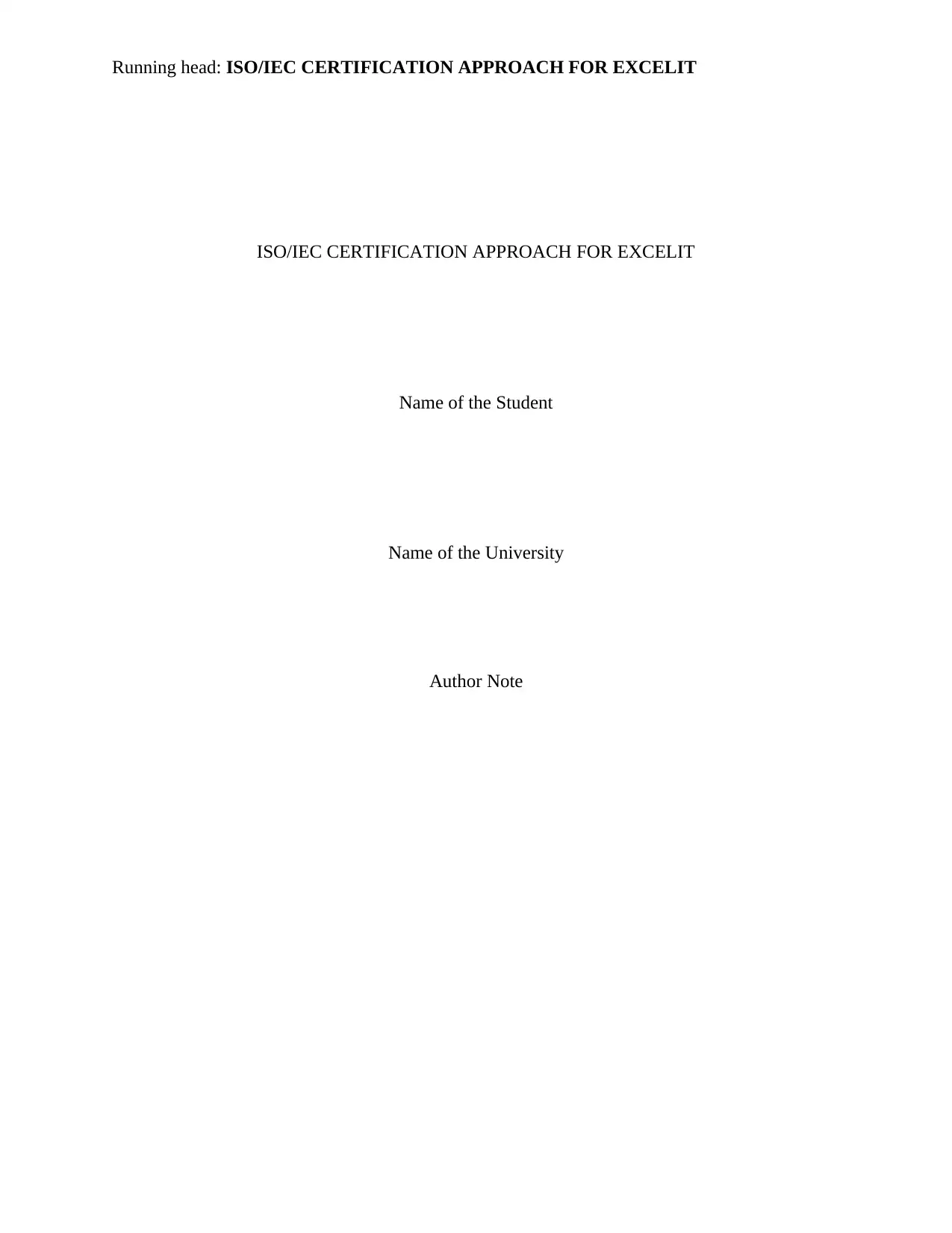
Running head: ISO/IEC CERTIFICATION APPROACH FOR EXCELIT
ISO/IEC CERTIFICATION APPROACH FOR EXCELIT
Name of the Student
Name of the University
Author Note
ISO/IEC CERTIFICATION APPROACH FOR EXCELIT
Name of the Student
Name of the University
Author Note
Paraphrase This Document
Need a fresh take? Get an instant paraphrase of this document with our AI Paraphraser
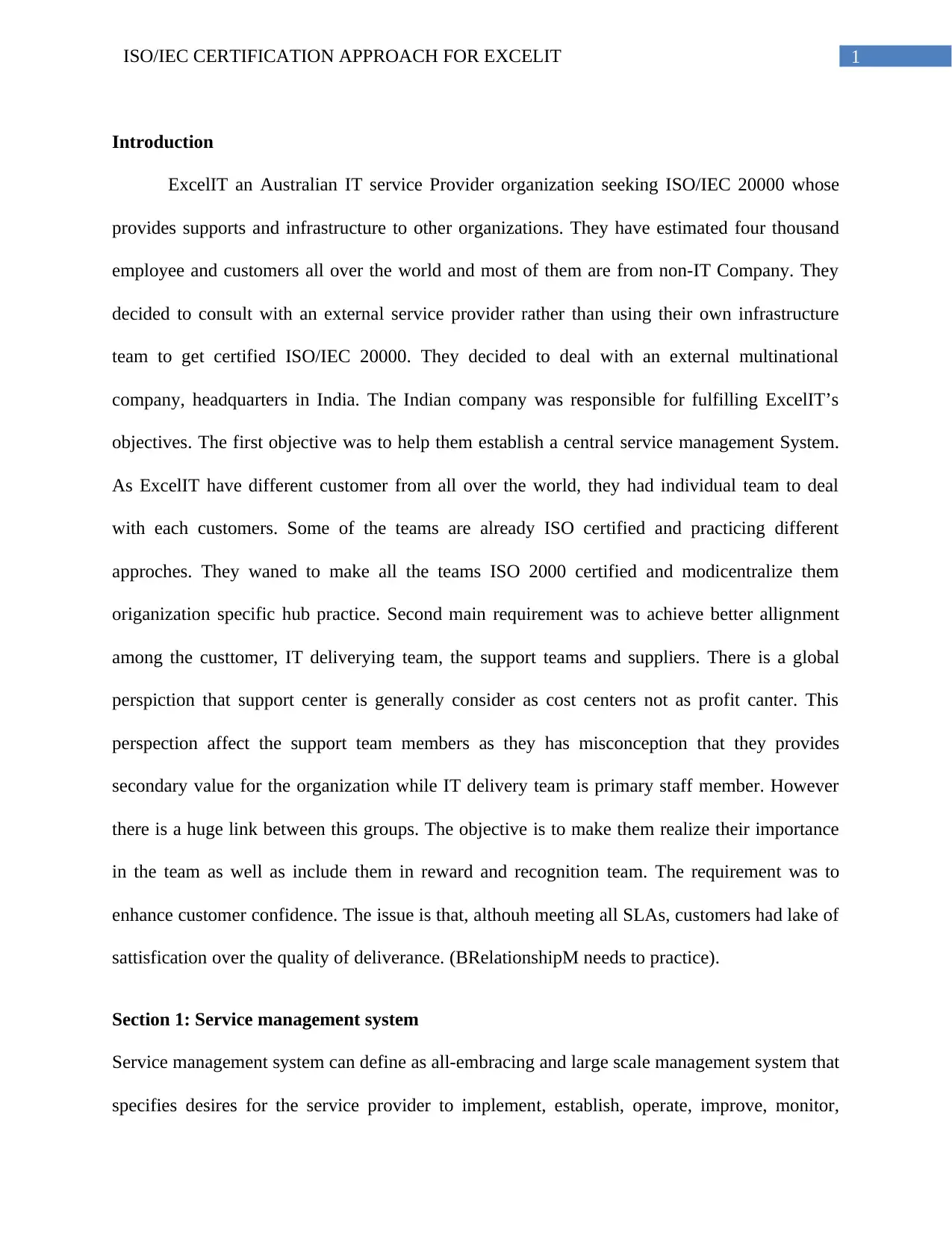
1ISO/IEC CERTIFICATION APPROACH FOR EXCELIT
Introduction
ExcelIT an Australian IT service Provider organization seeking ISO/IEC 20000 whose
provides supports and infrastructure to other organizations. They have estimated four thousand
employee and customers all over the world and most of them are from non-IT Company. They
decided to consult with an external service provider rather than using their own infrastructure
team to get certified ISO/IEC 20000. They decided to deal with an external multinational
company, headquarters in India. The Indian company was responsible for fulfilling ExcelIT’s
objectives. The first objective was to help them establish a central service management System.
As ExcelIT have different customer from all over the world, they had individual team to deal
with each customers. Some of the teams are already ISO certified and practicing different
approches. They waned to make all the teams ISO 2000 certified and modicentralize them
origanization specific hub practice. Second main requirement was to achieve better allignment
among the custtomer, IT deliverying team, the support teams and suppliers. There is a global
perspiction that support center is generally consider as cost centers not as profit canter. This
perspection affect the support team members as they has misconception that they provides
secondary value for the organization while IT delivery team is primary staff member. However
there is a huge link between this groups. The objective is to make them realize their importance
in the team as well as include them in reward and recognition team. The requirement was to
enhance customer confidence. The issue is that, althouh meeting all SLAs, customers had lake of
sattisfication over the quality of deliverance. (BRelationshipM needs to practice).
Section 1: Service management system
Service management system can define as all-embracing and large scale management system that
specifies desires for the service provider to implement, establish, operate, improve, monitor,
Introduction
ExcelIT an Australian IT service Provider organization seeking ISO/IEC 20000 whose
provides supports and infrastructure to other organizations. They have estimated four thousand
employee and customers all over the world and most of them are from non-IT Company. They
decided to consult with an external service provider rather than using their own infrastructure
team to get certified ISO/IEC 20000. They decided to deal with an external multinational
company, headquarters in India. The Indian company was responsible for fulfilling ExcelIT’s
objectives. The first objective was to help them establish a central service management System.
As ExcelIT have different customer from all over the world, they had individual team to deal
with each customers. Some of the teams are already ISO certified and practicing different
approches. They waned to make all the teams ISO 2000 certified and modicentralize them
origanization specific hub practice. Second main requirement was to achieve better allignment
among the custtomer, IT deliverying team, the support teams and suppliers. There is a global
perspiction that support center is generally consider as cost centers not as profit canter. This
perspection affect the support team members as they has misconception that they provides
secondary value for the organization while IT delivery team is primary staff member. However
there is a huge link between this groups. The objective is to make them realize their importance
in the team as well as include them in reward and recognition team. The requirement was to
enhance customer confidence. The issue is that, althouh meeting all SLAs, customers had lake of
sattisfication over the quality of deliverance. (BRelationshipM needs to practice).
Section 1: Service management system
Service management system can define as all-embracing and large scale management system that
specifies desires for the service provider to implement, establish, operate, improve, monitor,
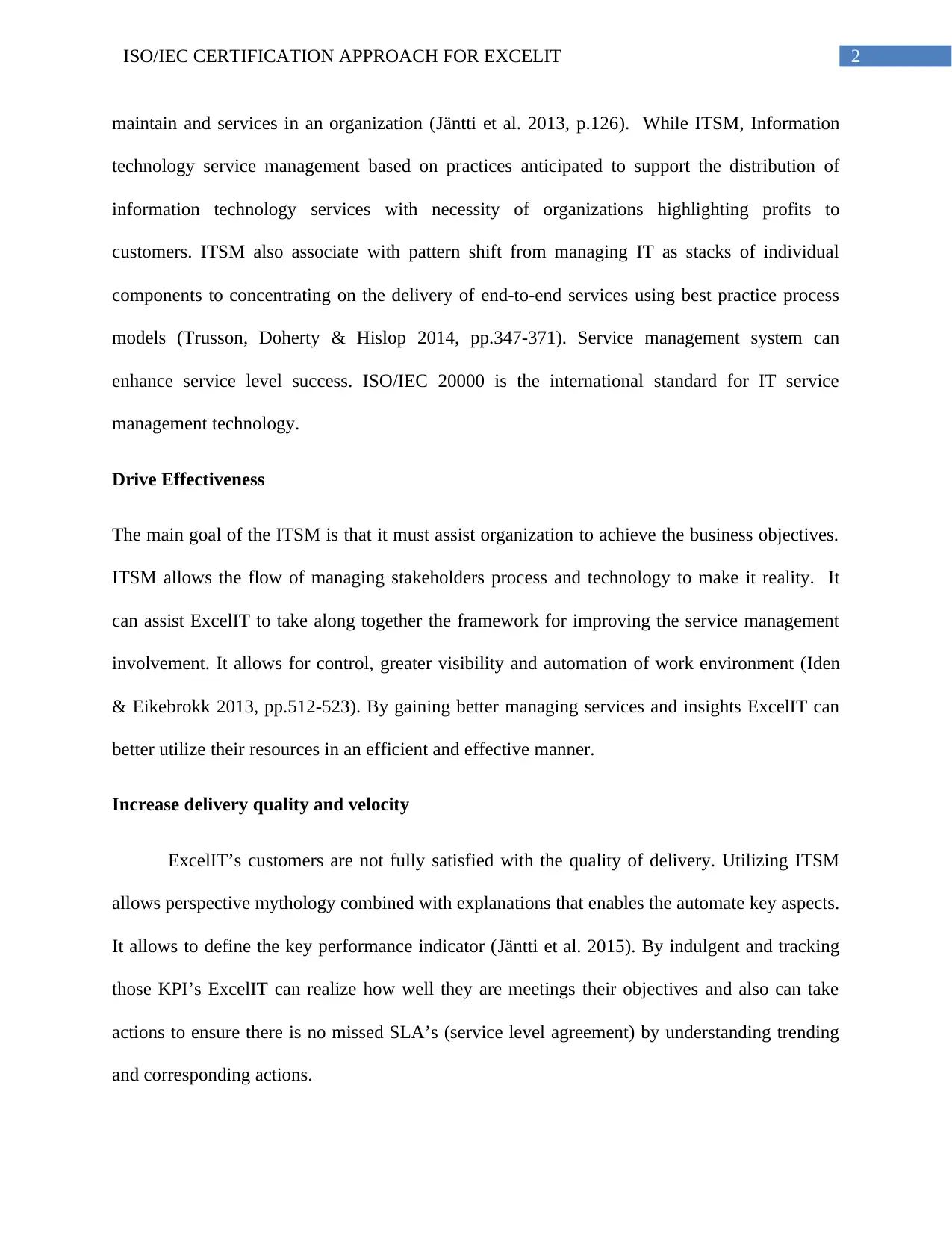
2ISO/IEC CERTIFICATION APPROACH FOR EXCELIT
maintain and services in an organization (Jäntti et al. 2013, p.126). While ITSM, Information
technology service management based on practices anticipated to support the distribution of
information technology services with necessity of organizations highlighting profits to
customers. ITSM also associate with pattern shift from managing IT as stacks of individual
components to concentrating on the delivery of end-to-end services using best practice process
models (Trusson, Doherty & Hislop 2014, pp.347-371). Service management system can
enhance service level success. ISO/IEC 20000 is the international standard for IT service
management technology.
Drive Effectiveness
The main goal of the ITSM is that it must assist organization to achieve the business objectives.
ITSM allows the flow of managing stakeholders process and technology to make it reality. It
can assist ExcelIT to take along together the framework for improving the service management
involvement. It allows for control, greater visibility and automation of work environment (Iden
& Eikebrokk 2013, pp.512-523). By gaining better managing services and insights ExcelIT can
better utilize their resources in an efficient and effective manner.
Increase delivery quality and velocity
ExcelIT’s customers are not fully satisfied with the quality of delivery. Utilizing ITSM
allows perspective mythology combined with explanations that enables the automate key aspects.
It allows to define the key performance indicator (Jäntti et al. 2015). By indulgent and tracking
those KPI’s ExcelIT can realize how well they are meetings their objectives and also can take
actions to ensure there is no missed SLA’s (service level agreement) by understanding trending
and corresponding actions.
maintain and services in an organization (Jäntti et al. 2013, p.126). While ITSM, Information
technology service management based on practices anticipated to support the distribution of
information technology services with necessity of organizations highlighting profits to
customers. ITSM also associate with pattern shift from managing IT as stacks of individual
components to concentrating on the delivery of end-to-end services using best practice process
models (Trusson, Doherty & Hislop 2014, pp.347-371). Service management system can
enhance service level success. ISO/IEC 20000 is the international standard for IT service
management technology.
Drive Effectiveness
The main goal of the ITSM is that it must assist organization to achieve the business objectives.
ITSM allows the flow of managing stakeholders process and technology to make it reality. It
can assist ExcelIT to take along together the framework for improving the service management
involvement. It allows for control, greater visibility and automation of work environment (Iden
& Eikebrokk 2013, pp.512-523). By gaining better managing services and insights ExcelIT can
better utilize their resources in an efficient and effective manner.
Increase delivery quality and velocity
ExcelIT’s customers are not fully satisfied with the quality of delivery. Utilizing ITSM
allows perspective mythology combined with explanations that enables the automate key aspects.
It allows to define the key performance indicator (Jäntti et al. 2015). By indulgent and tracking
those KPI’s ExcelIT can realize how well they are meetings their objectives and also can take
actions to ensure there is no missed SLA’s (service level agreement) by understanding trending
and corresponding actions.
⊘ This is a preview!⊘
Do you want full access?
Subscribe today to unlock all pages.

Trusted by 1+ million students worldwide
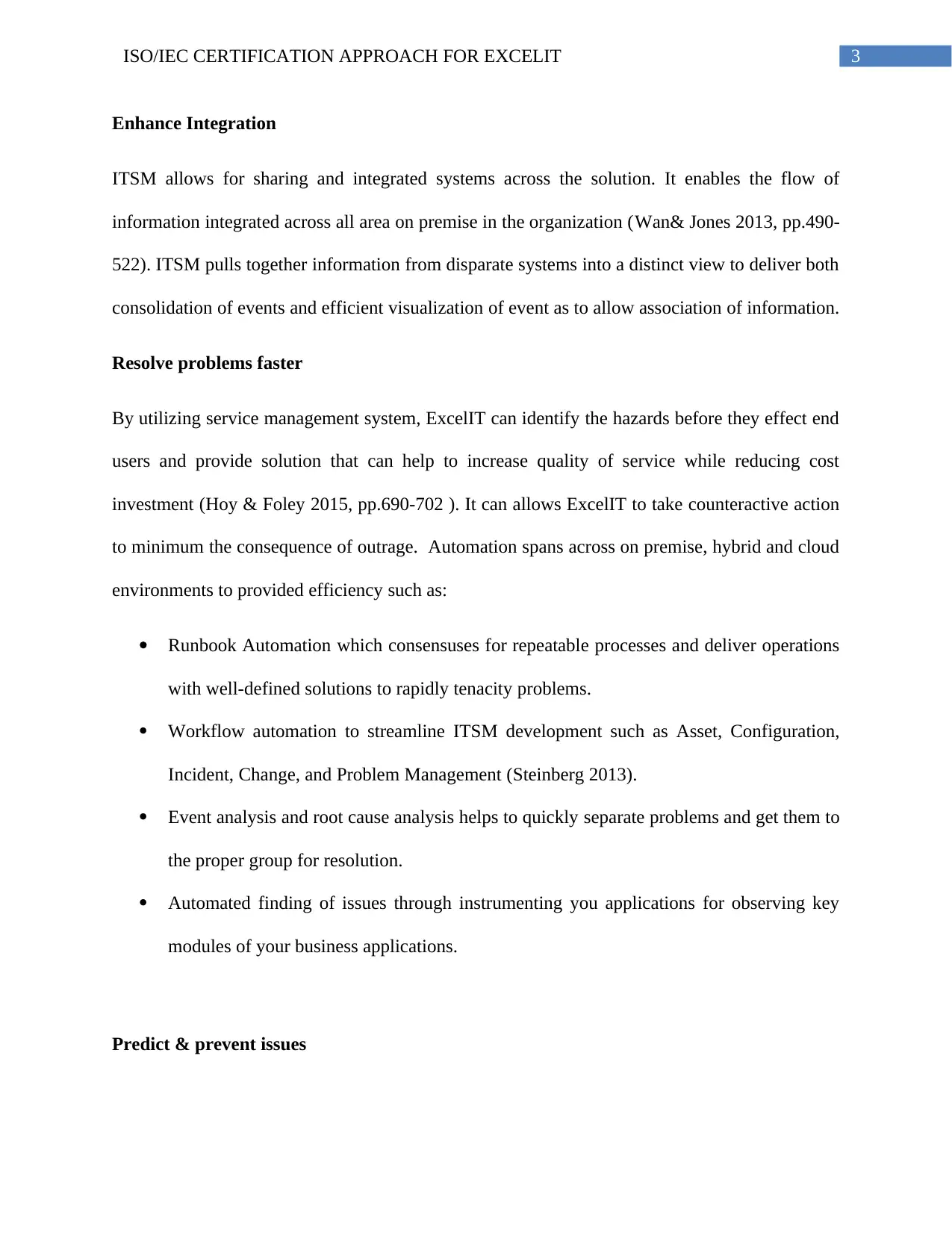
3ISO/IEC CERTIFICATION APPROACH FOR EXCELIT
Enhance Integration
ITSM allows for sharing and integrated systems across the solution. It enables the flow of
information integrated across all area on premise in the organization (Wan& Jones 2013, pp.490-
522). ITSM pulls together information from disparate systems into a distinct view to deliver both
consolidation of events and efficient visualization of event as to allow association of information.
Resolve problems faster
By utilizing service management system, ExcelIT can identify the hazards before they effect end
users and provide solution that can help to increase quality of service while reducing cost
investment (Hoy & Foley 2015, pp.690-702 ). It can allows ExcelIT to take counteractive action
to minimum the consequence of outrage. Automation spans across on premise, hybrid and cloud
environments to provided efficiency such as:
Runbook Automation which consensuses for repeatable processes and deliver operations
with well-defined solutions to rapidly tenacity problems.
Workflow automation to streamline ITSM development such as Asset, Configuration,
Incident, Change, and Problem Management (Steinberg 2013).
Event analysis and root cause analysis helps to quickly separate problems and get them to
the proper group for resolution.
Automated finding of issues through instrumenting you applications for observing key
modules of your business applications.
Predict & prevent issues
Enhance Integration
ITSM allows for sharing and integrated systems across the solution. It enables the flow of
information integrated across all area on premise in the organization (Wan& Jones 2013, pp.490-
522). ITSM pulls together information from disparate systems into a distinct view to deliver both
consolidation of events and efficient visualization of event as to allow association of information.
Resolve problems faster
By utilizing service management system, ExcelIT can identify the hazards before they effect end
users and provide solution that can help to increase quality of service while reducing cost
investment (Hoy & Foley 2015, pp.690-702 ). It can allows ExcelIT to take counteractive action
to minimum the consequence of outrage. Automation spans across on premise, hybrid and cloud
environments to provided efficiency such as:
Runbook Automation which consensuses for repeatable processes and deliver operations
with well-defined solutions to rapidly tenacity problems.
Workflow automation to streamline ITSM development such as Asset, Configuration,
Incident, Change, and Problem Management (Steinberg 2013).
Event analysis and root cause analysis helps to quickly separate problems and get them to
the proper group for resolution.
Automated finding of issues through instrumenting you applications for observing key
modules of your business applications.
Predict & prevent issues
Paraphrase This Document
Need a fresh take? Get an instant paraphrase of this document with our AI Paraphraser
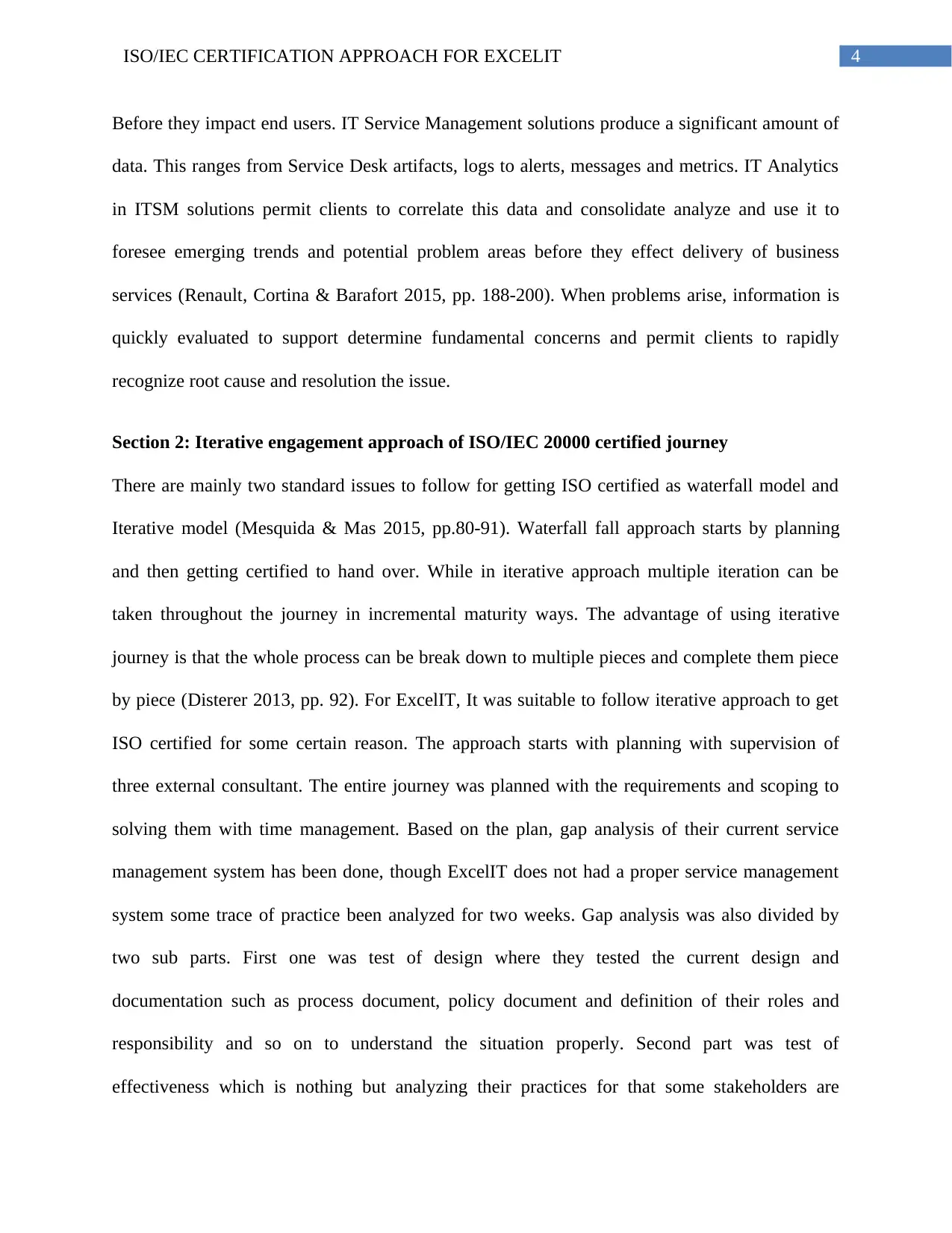
4ISO/IEC CERTIFICATION APPROACH FOR EXCELIT
Before they impact end users. IT Service Management solutions produce a significant amount of
data. This ranges from Service Desk artifacts, logs to alerts, messages and metrics. IT Analytics
in ITSM solutions permit clients to correlate this data and consolidate analyze and use it to
foresee emerging trends and potential problem areas before they effect delivery of business
services (Renault, Cortina & Barafort 2015, pp. 188-200). When problems arise, information is
quickly evaluated to support determine fundamental concerns and permit clients to rapidly
recognize root cause and resolution the issue.
Section 2: Iterative engagement approach of ISO/IEC 20000 certified journey
There are mainly two standard issues to follow for getting ISO certified as waterfall model and
Iterative model (Mesquida & Mas 2015, pp.80-91). Waterfall fall approach starts by planning
and then getting certified to hand over. While in iterative approach multiple iteration can be
taken throughout the journey in incremental maturity ways. The advantage of using iterative
journey is that the whole process can be break down to multiple pieces and complete them piece
by piece (Disterer 2013, pp. 92). For ExcelIT, It was suitable to follow iterative approach to get
ISO certified for some certain reason. The approach starts with planning with supervision of
three external consultant. The entire journey was planned with the requirements and scoping to
solving them with time management. Based on the plan, gap analysis of their current service
management system has been done, though ExcelIT does not had a proper service management
system some trace of practice been analyzed for two weeks. Gap analysis was also divided by
two sub parts. First one was test of design where they tested the current design and
documentation such as process document, policy document and definition of their roles and
responsibility and so on to understand the situation properly. Second part was test of
effectiveness which is nothing but analyzing their practices for that some stakeholders are
Before they impact end users. IT Service Management solutions produce a significant amount of
data. This ranges from Service Desk artifacts, logs to alerts, messages and metrics. IT Analytics
in ITSM solutions permit clients to correlate this data and consolidate analyze and use it to
foresee emerging trends and potential problem areas before they effect delivery of business
services (Renault, Cortina & Barafort 2015, pp. 188-200). When problems arise, information is
quickly evaluated to support determine fundamental concerns and permit clients to rapidly
recognize root cause and resolution the issue.
Section 2: Iterative engagement approach of ISO/IEC 20000 certified journey
There are mainly two standard issues to follow for getting ISO certified as waterfall model and
Iterative model (Mesquida & Mas 2015, pp.80-91). Waterfall fall approach starts by planning
and then getting certified to hand over. While in iterative approach multiple iteration can be
taken throughout the journey in incremental maturity ways. The advantage of using iterative
journey is that the whole process can be break down to multiple pieces and complete them piece
by piece (Disterer 2013, pp. 92). For ExcelIT, It was suitable to follow iterative approach to get
ISO certified for some certain reason. The approach starts with planning with supervision of
three external consultant. The entire journey was planned with the requirements and scoping to
solving them with time management. Based on the plan, gap analysis of their current service
management system has been done, though ExcelIT does not had a proper service management
system some trace of practice been analyzed for two weeks. Gap analysis was also divided by
two sub parts. First one was test of design where they tested the current design and
documentation such as process document, policy document and definition of their roles and
responsibility and so on to understand the situation properly. Second part was test of
effectiveness which is nothing but analyzing their practices for that some stakeholders are
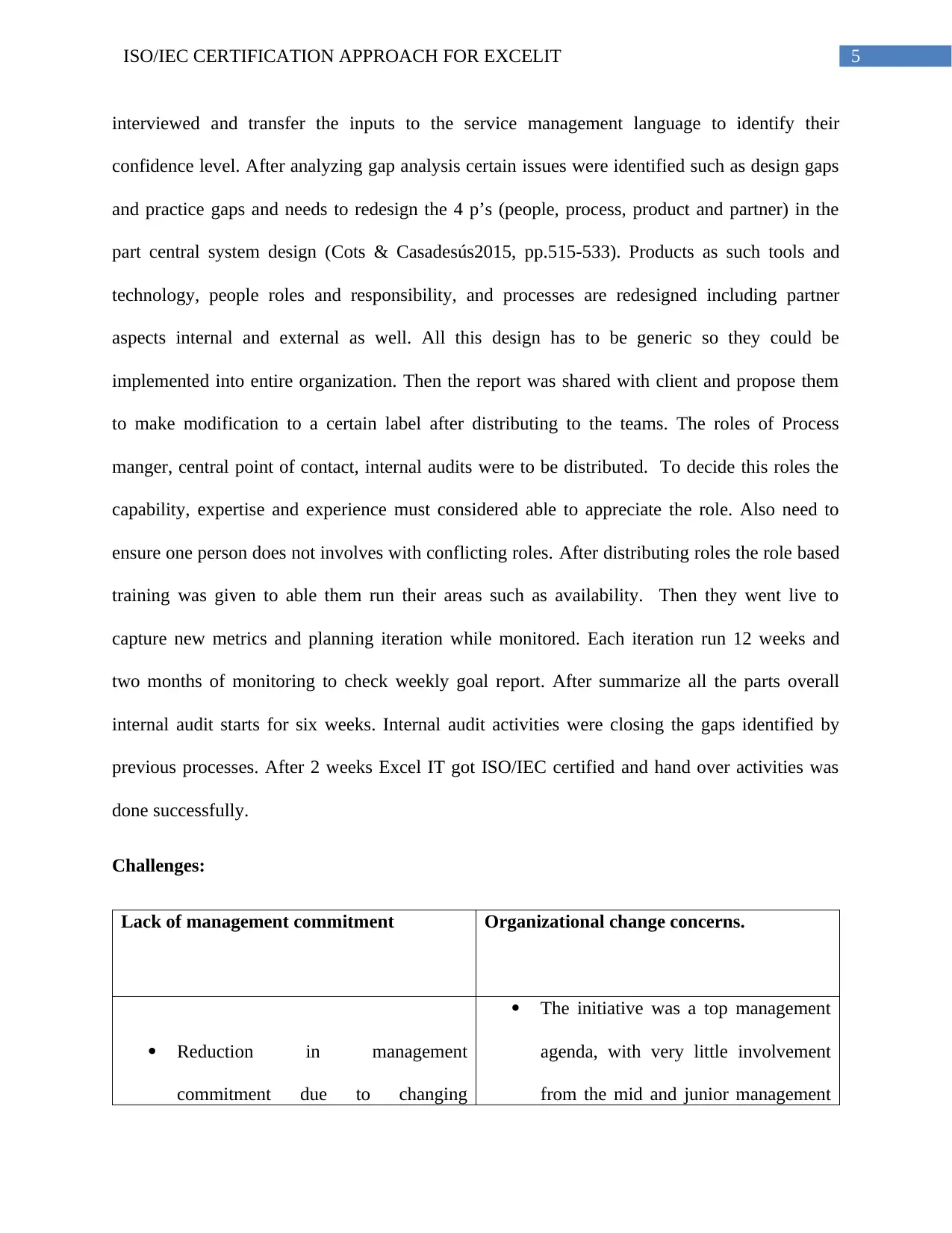
5ISO/IEC CERTIFICATION APPROACH FOR EXCELIT
interviewed and transfer the inputs to the service management language to identify their
confidence level. After analyzing gap analysis certain issues were identified such as design gaps
and practice gaps and needs to redesign the 4 p’s (people, process, product and partner) in the
part central system design (Cots & Casadesús2015, pp.515-533). Products as such tools and
technology, people roles and responsibility, and processes are redesigned including partner
aspects internal and external as well. All this design has to be generic so they could be
implemented into entire organization. Then the report was shared with client and propose them
to make modification to a certain label after distributing to the teams. The roles of Process
manger, central point of contact, internal audits were to be distributed. To decide this roles the
capability, expertise and experience must considered able to appreciate the role. Also need to
ensure one person does not involves with conflicting roles. After distributing roles the role based
training was given to able them run their areas such as availability. Then they went live to
capture new metrics and planning iteration while monitored. Each iteration run 12 weeks and
two months of monitoring to check weekly goal report. After summarize all the parts overall
internal audit starts for six weeks. Internal audit activities were closing the gaps identified by
previous processes. After 2 weeks Excel IT got ISO/IEC certified and hand over activities was
done successfully.
Challenges:
Lack of management commitment Organizational change concerns.
Reduction in management
commitment due to changing
The initiative was a top management
agenda, with very little involvement
from the mid and junior management
interviewed and transfer the inputs to the service management language to identify their
confidence level. After analyzing gap analysis certain issues were identified such as design gaps
and practice gaps and needs to redesign the 4 p’s (people, process, product and partner) in the
part central system design (Cots & Casadesús2015, pp.515-533). Products as such tools and
technology, people roles and responsibility, and processes are redesigned including partner
aspects internal and external as well. All this design has to be generic so they could be
implemented into entire organization. Then the report was shared with client and propose them
to make modification to a certain label after distributing to the teams. The roles of Process
manger, central point of contact, internal audits were to be distributed. To decide this roles the
capability, expertise and experience must considered able to appreciate the role. Also need to
ensure one person does not involves with conflicting roles. After distributing roles the role based
training was given to able them run their areas such as availability. Then they went live to
capture new metrics and planning iteration while monitored. Each iteration run 12 weeks and
two months of monitoring to check weekly goal report. After summarize all the parts overall
internal audit starts for six weeks. Internal audit activities were closing the gaps identified by
previous processes. After 2 weeks Excel IT got ISO/IEC certified and hand over activities was
done successfully.
Challenges:
Lack of management commitment Organizational change concerns.
Reduction in management
commitment due to changing
The initiative was a top management
agenda, with very little involvement
from the mid and junior management
⊘ This is a preview!⊘
Do you want full access?
Subscribe today to unlock all pages.

Trusted by 1+ million students worldwide
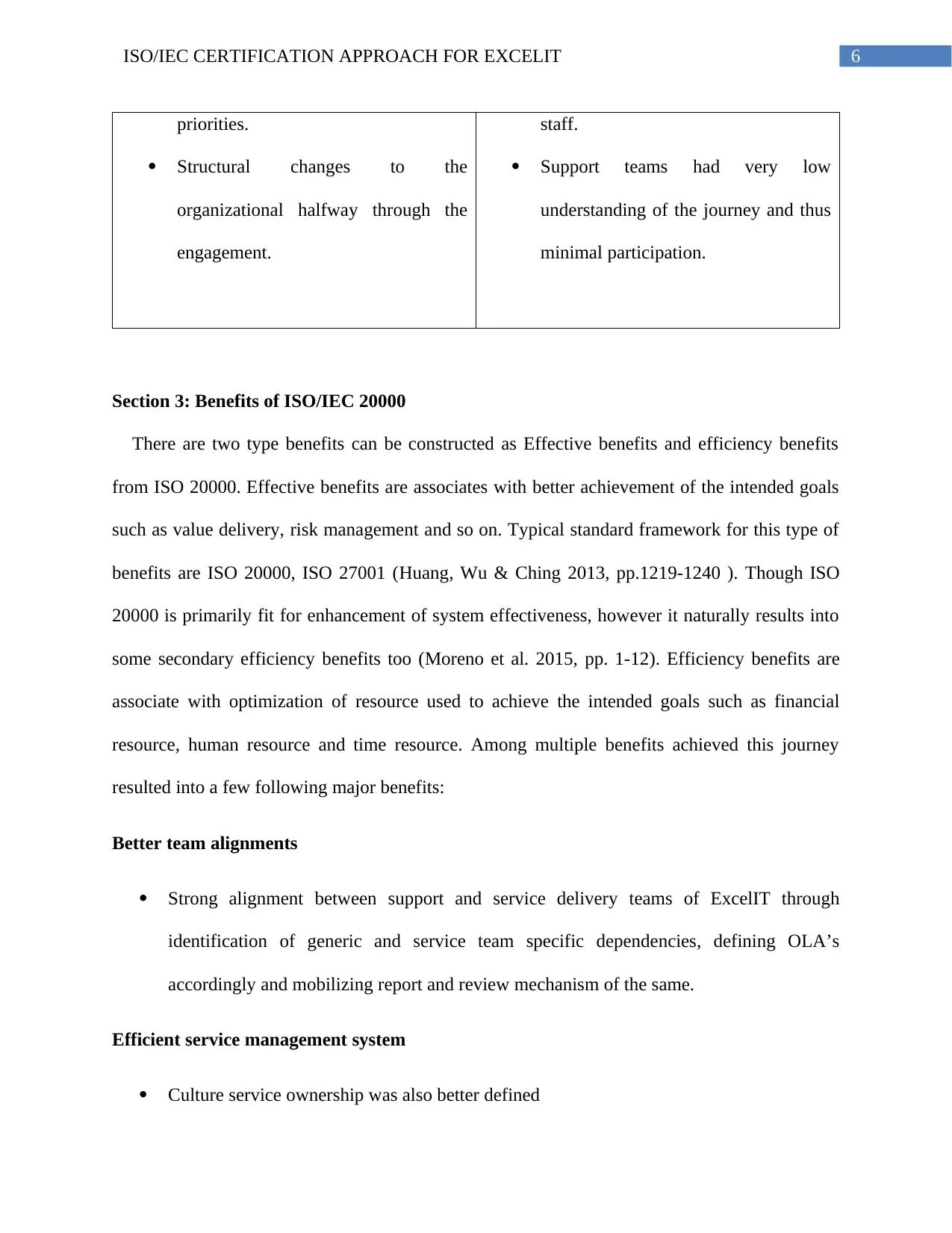
6ISO/IEC CERTIFICATION APPROACH FOR EXCELIT
priorities.
Structural changes to the
organizational halfway through the
engagement.
staff.
Support teams had very low
understanding of the journey and thus
minimal participation.
Section 3: Benefits of ISO/IEC 20000
There are two type benefits can be constructed as Effective benefits and efficiency benefits
from ISO 20000. Effective benefits are associates with better achievement of the intended goals
such as value delivery, risk management and so on. Typical standard framework for this type of
benefits are ISO 20000, ISO 27001 (Huang, Wu & Ching 2013, pp.1219-1240 ). Though ISO
20000 is primarily fit for enhancement of system effectiveness, however it naturally results into
some secondary efficiency benefits too (Moreno et al. 2015, pp. 1-12). Efficiency benefits are
associate with optimization of resource used to achieve the intended goals such as financial
resource, human resource and time resource. Among multiple benefits achieved this journey
resulted into a few following major benefits:
Better team alignments
Strong alignment between support and service delivery teams of ExcelIT through
identification of generic and service team specific dependencies, defining OLA’s
accordingly and mobilizing report and review mechanism of the same.
Efficient service management system
Culture service ownership was also better defined
priorities.
Structural changes to the
organizational halfway through the
engagement.
staff.
Support teams had very low
understanding of the journey and thus
minimal participation.
Section 3: Benefits of ISO/IEC 20000
There are two type benefits can be constructed as Effective benefits and efficiency benefits
from ISO 20000. Effective benefits are associates with better achievement of the intended goals
such as value delivery, risk management and so on. Typical standard framework for this type of
benefits are ISO 20000, ISO 27001 (Huang, Wu & Ching 2013, pp.1219-1240 ). Though ISO
20000 is primarily fit for enhancement of system effectiveness, however it naturally results into
some secondary efficiency benefits too (Moreno et al. 2015, pp. 1-12). Efficiency benefits are
associate with optimization of resource used to achieve the intended goals such as financial
resource, human resource and time resource. Among multiple benefits achieved this journey
resulted into a few following major benefits:
Better team alignments
Strong alignment between support and service delivery teams of ExcelIT through
identification of generic and service team specific dependencies, defining OLA’s
accordingly and mobilizing report and review mechanism of the same.
Efficient service management system
Culture service ownership was also better defined
Paraphrase This Document
Need a fresh take? Get an instant paraphrase of this document with our AI Paraphraser
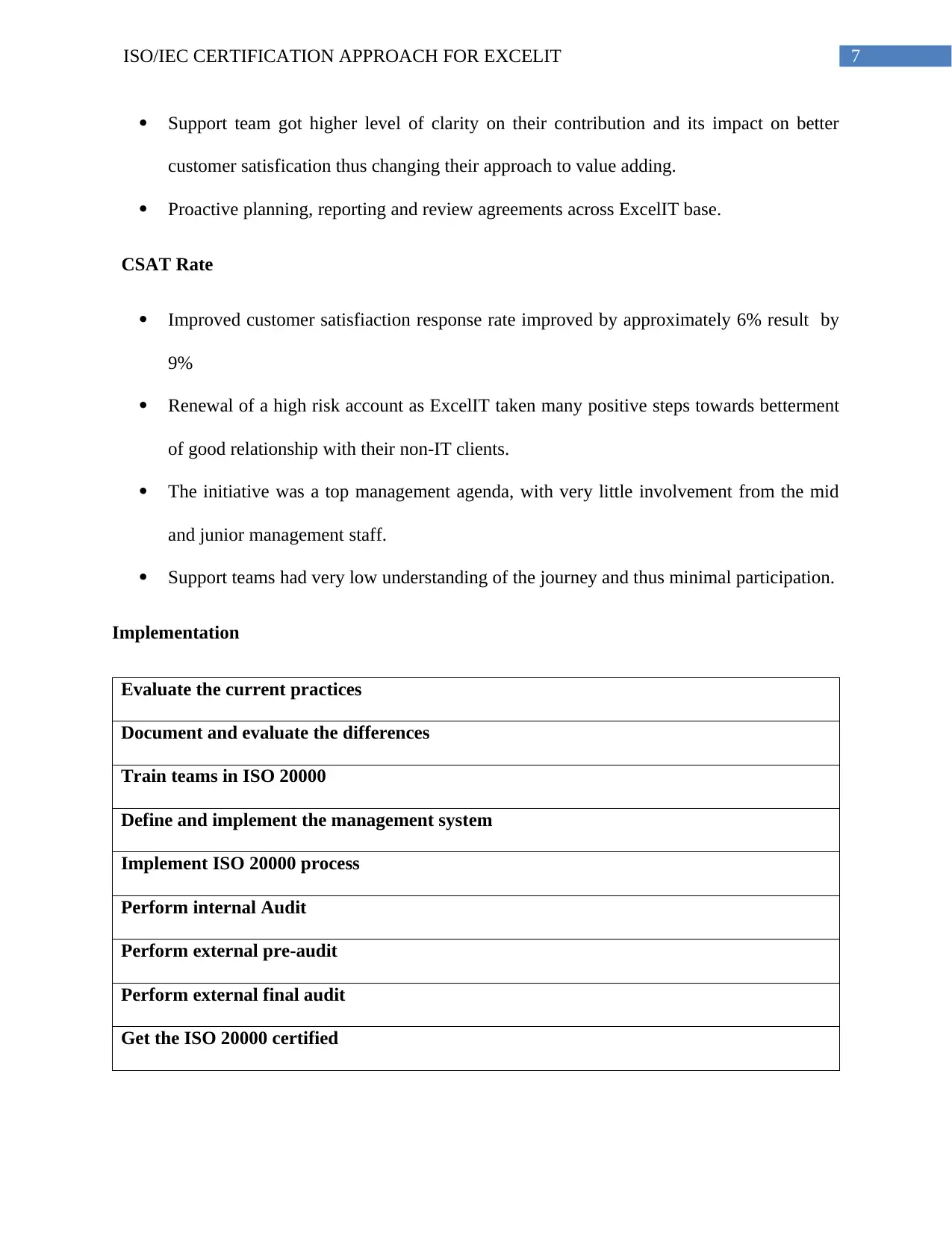
7ISO/IEC CERTIFICATION APPROACH FOR EXCELIT
Support team got higher level of clarity on their contribution and its impact on better
customer satisfication thus changing their approach to value adding.
Proactive planning, reporting and review agreements across ExcelIT base.
CSAT Rate
Improved customer satisfiaction response rate improved by approximately 6% result by
9%
Renewal of a high risk account as ExcelIT taken many positive steps towards betterment
of good relationship with their non-IT clients.
The initiative was a top management agenda, with very little involvement from the mid
and junior management staff.
Support teams had very low understanding of the journey and thus minimal participation.
Implementation
Evaluate the current practices
Document and evaluate the differences
Train teams in ISO 20000
Define and implement the management system
Implement ISO 20000 process
Perform internal Audit
Perform external pre-audit
Perform external final audit
Get the ISO 20000 certified
Support team got higher level of clarity on their contribution and its impact on better
customer satisfication thus changing their approach to value adding.
Proactive planning, reporting and review agreements across ExcelIT base.
CSAT Rate
Improved customer satisfiaction response rate improved by approximately 6% result by
9%
Renewal of a high risk account as ExcelIT taken many positive steps towards betterment
of good relationship with their non-IT clients.
The initiative was a top management agenda, with very little involvement from the mid
and junior management staff.
Support teams had very low understanding of the journey and thus minimal participation.
Implementation
Evaluate the current practices
Document and evaluate the differences
Train teams in ISO 20000
Define and implement the management system
Implement ISO 20000 process
Perform internal Audit
Perform external pre-audit
Perform external final audit
Get the ISO 20000 certified
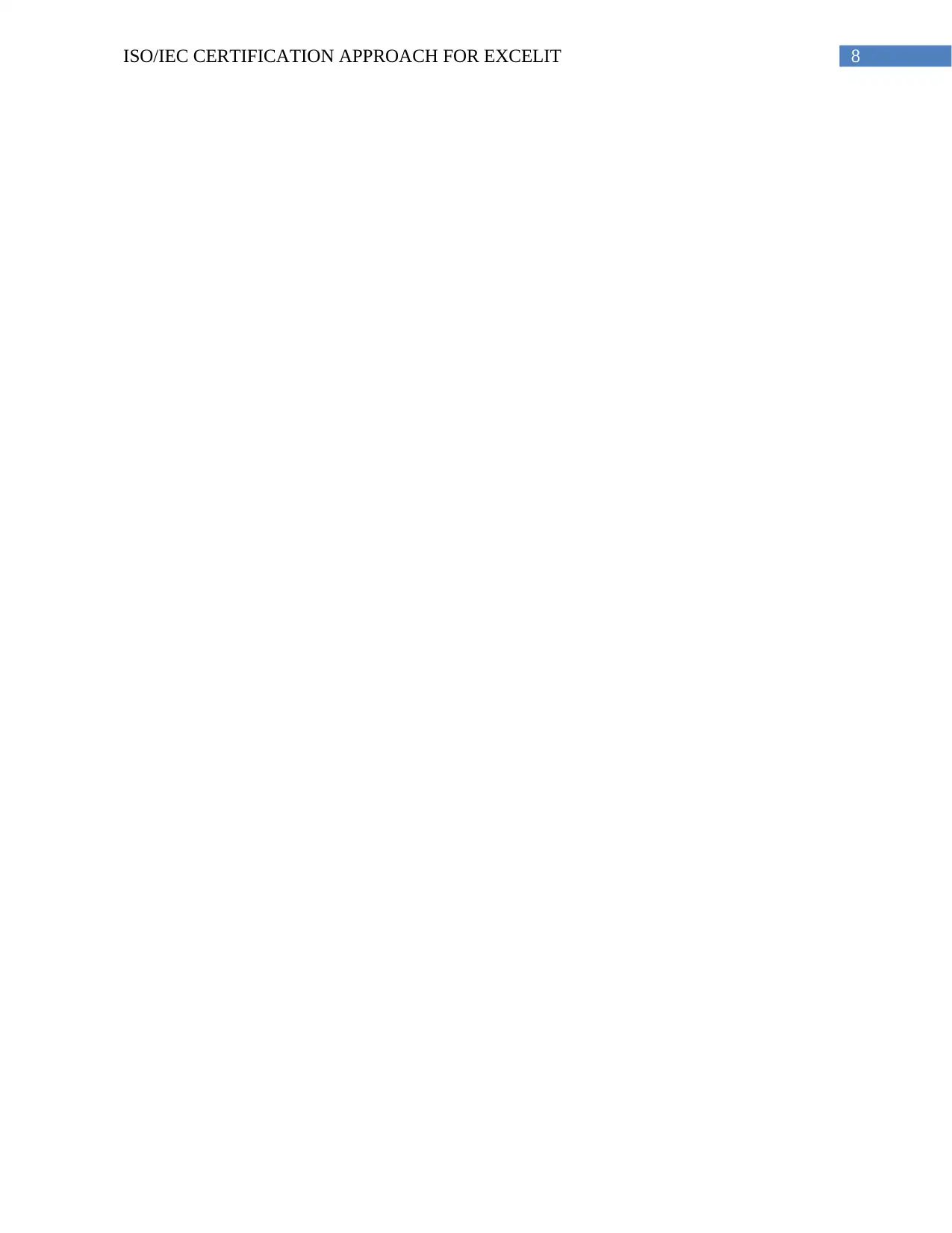
8ISO/IEC CERTIFICATION APPROACH FOR EXCELIT
⊘ This is a preview!⊘
Do you want full access?
Subscribe today to unlock all pages.

Trusted by 1+ million students worldwide
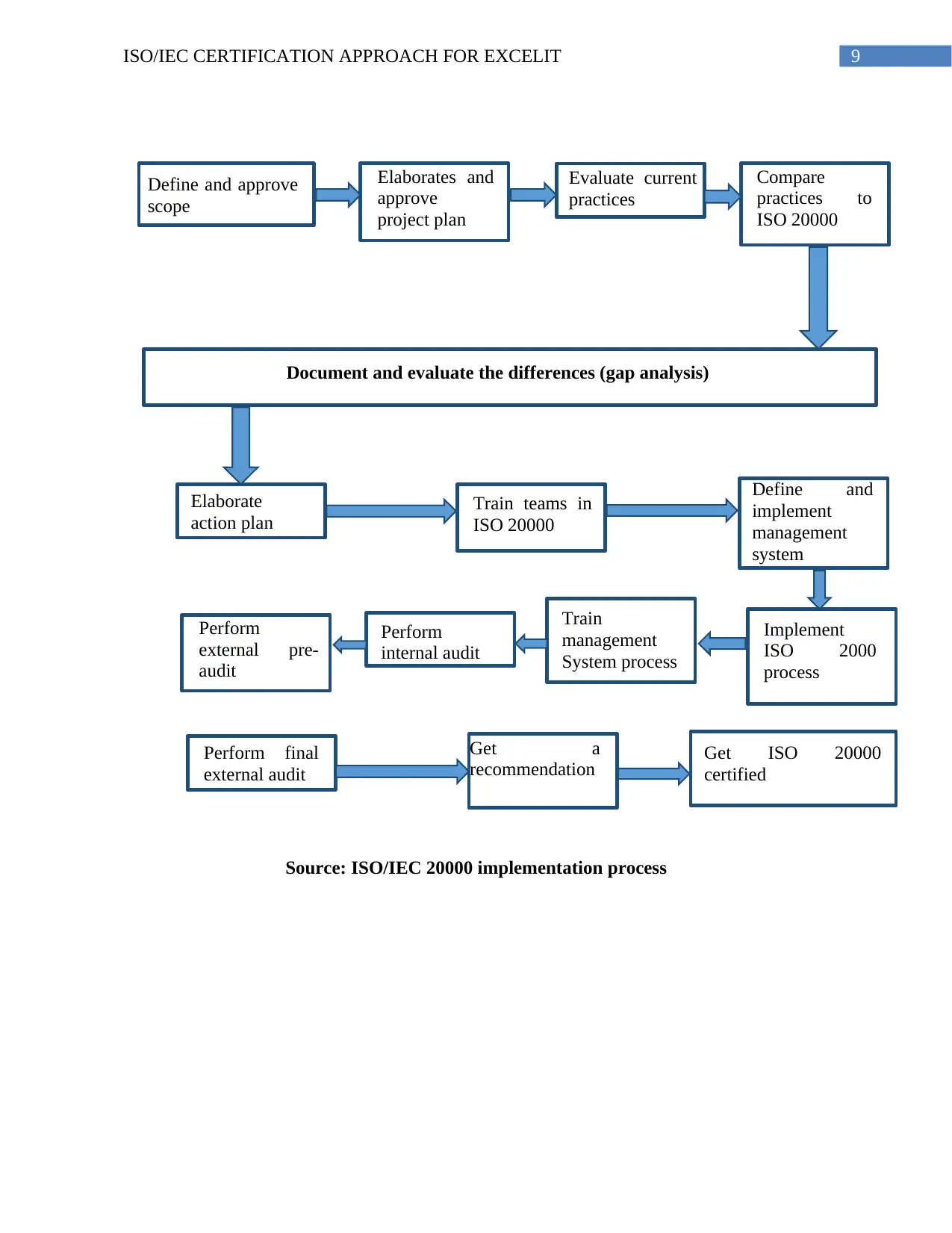
9ISO/IEC CERTIFICATION APPROACH FOR EXCELIT
Define and approve
scope
Elaborates and
approve
project plan
Evaluate current
practices
Compare
practices to
ISO 20000
Document and evaluate the differences (gap analysis)
Elaborate
action plan
Train teams in
ISO 20000
Define and
implement
management
system
Perform
external pre-
audit
Perform
internal audit
Train
management
System process
Perform final
external audit
Get a
recommendation Get ISO 20000
certified
Implement
ISO 2000
process
Source: ISO/IEC 20000 implementation process
Define and approve
scope
Elaborates and
approve
project plan
Evaluate current
practices
Compare
practices to
ISO 20000
Document and evaluate the differences (gap analysis)
Elaborate
action plan
Train teams in
ISO 20000
Define and
implement
management
system
Perform
external pre-
audit
Perform
internal audit
Train
management
System process
Perform final
external audit
Get a
recommendation Get ISO 20000
certified
Implement
ISO 2000
process
Source: ISO/IEC 20000 implementation process
Paraphrase This Document
Need a fresh take? Get an instant paraphrase of this document with our AI Paraphraser
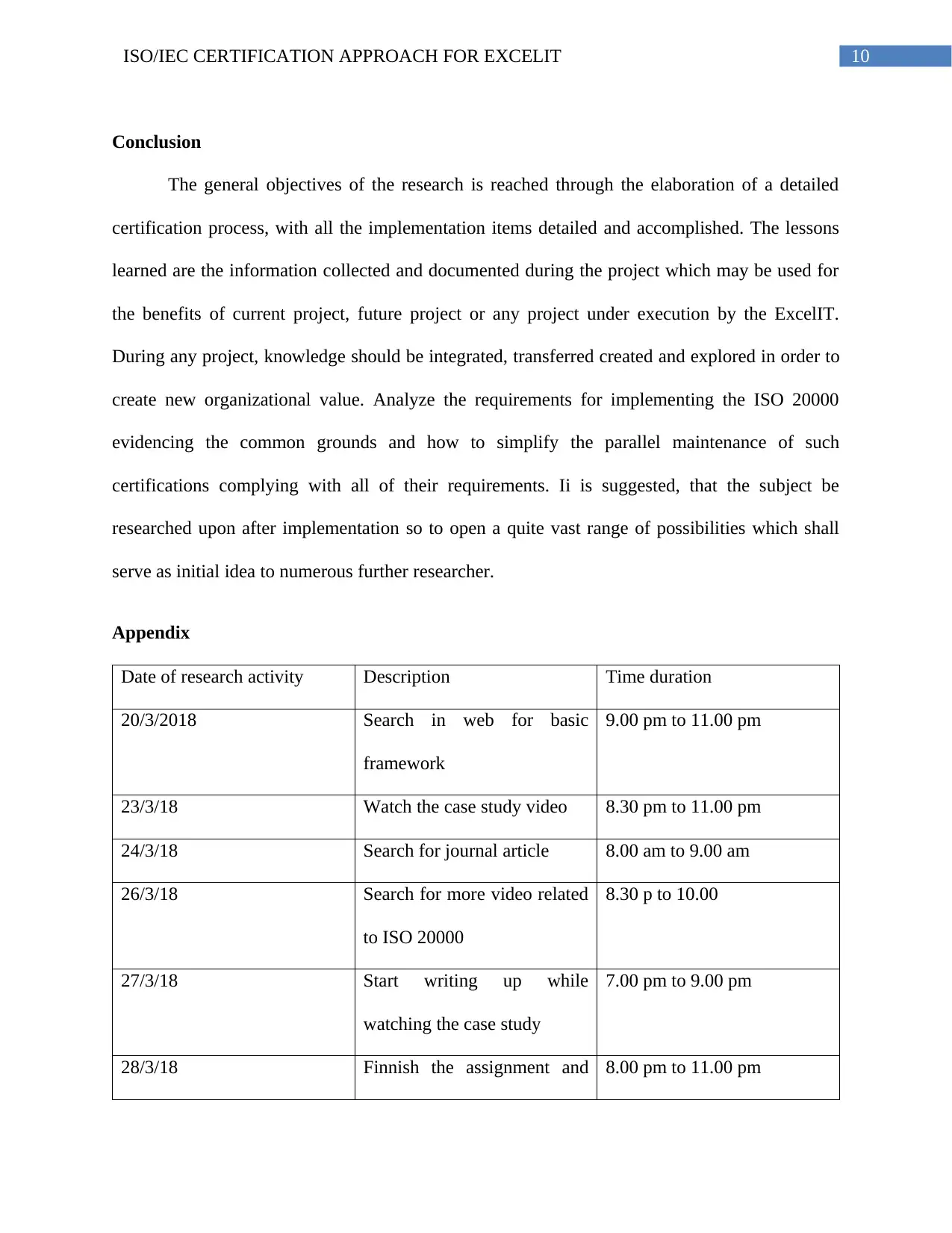
10ISO/IEC CERTIFICATION APPROACH FOR EXCELIT
Conclusion
The general objectives of the research is reached through the elaboration of a detailed
certification process, with all the implementation items detailed and accomplished. The lessons
learned are the information collected and documented during the project which may be used for
the benefits of current project, future project or any project under execution by the ExcelIT.
During any project, knowledge should be integrated, transferred created and explored in order to
create new organizational value. Analyze the requirements for implementing the ISO 20000
evidencing the common grounds and how to simplify the parallel maintenance of such
certifications complying with all of their requirements. Ii is suggested, that the subject be
researched upon after implementation so to open a quite vast range of possibilities which shall
serve as initial idea to numerous further researcher.
Appendix
Date of research activity Description Time duration
20/3/2018 Search in web for basic
framework
9.00 pm to 11.00 pm
23/3/18 Watch the case study video 8.30 pm to 11.00 pm
24/3/18 Search for journal article 8.00 am to 9.00 am
26/3/18 Search for more video related
to ISO 20000
8.30 p to 10.00
27/3/18 Start writing up while
watching the case study
7.00 pm to 9.00 pm
28/3/18 Finnish the assignment and 8.00 pm to 11.00 pm
Conclusion
The general objectives of the research is reached through the elaboration of a detailed
certification process, with all the implementation items detailed and accomplished. The lessons
learned are the information collected and documented during the project which may be used for
the benefits of current project, future project or any project under execution by the ExcelIT.
During any project, knowledge should be integrated, transferred created and explored in order to
create new organizational value. Analyze the requirements for implementing the ISO 20000
evidencing the common grounds and how to simplify the parallel maintenance of such
certifications complying with all of their requirements. Ii is suggested, that the subject be
researched upon after implementation so to open a quite vast range of possibilities which shall
serve as initial idea to numerous further researcher.
Appendix
Date of research activity Description Time duration
20/3/2018 Search in web for basic
framework
9.00 pm to 11.00 pm
23/3/18 Watch the case study video 8.30 pm to 11.00 pm
24/3/18 Search for journal article 8.00 am to 9.00 am
26/3/18 Search for more video related
to ISO 20000
8.30 p to 10.00
27/3/18 Start writing up while
watching the case study
7.00 pm to 9.00 pm
28/3/18 Finnish the assignment and 8.00 pm to 11.00 pm
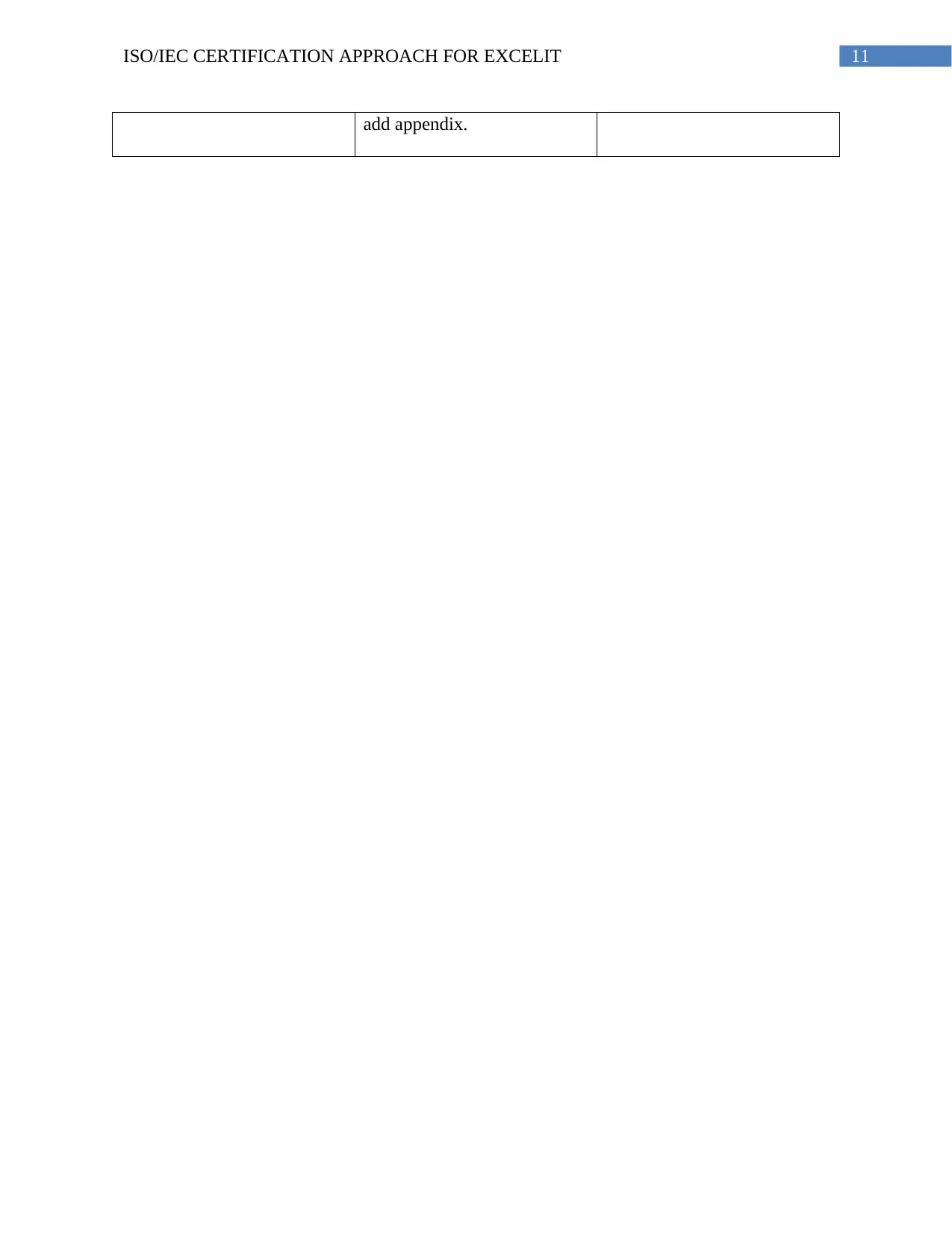
11ISO/IEC CERTIFICATION APPROACH FOR EXCELIT
add appendix.
add appendix.
⊘ This is a preview!⊘
Do you want full access?
Subscribe today to unlock all pages.

Trusted by 1+ million students worldwide
1 out of 13
Related Documents
Your All-in-One AI-Powered Toolkit for Academic Success.
+13062052269
info@desklib.com
Available 24*7 on WhatsApp / Email
![[object Object]](/_next/static/media/star-bottom.7253800d.svg)
Unlock your academic potential
Copyright © 2020–2025 A2Z Services. All Rights Reserved. Developed and managed by ZUCOL.



